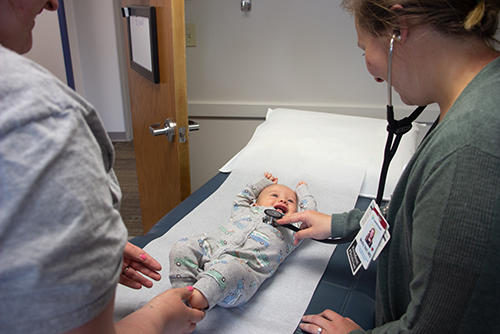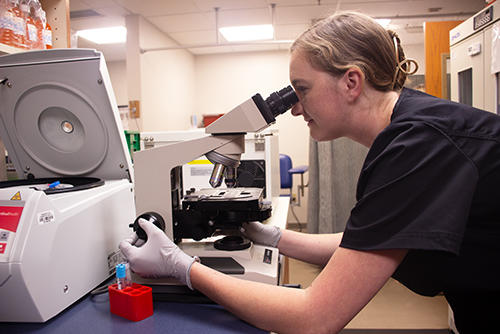Curriculum and Call
Our program focuses on developing and preparing collaborative, rural-ready, full-spectrum family medicine physicians.
The majority of our graduates practice in communities with populations of less than 25,000. Most clinical rotations are hosted at three primary training sites: Duluth Family Medicine Clinic, St. Mary’s Hospital and St. Luke’s Hospital.
Rotations and Electives
View rotations below for each year of residency, longitudinal curriculum, and electives.
Procedures
Residents learn clinic office procedures and hospital procedures.
Moonlighting
Numerous moonlighting activities are available for second- and third-year residents.
Global Health
Opportunities include international and global-local electives, courses, seminars, conferences, and fellowships.
Programmatic Courses
The department sponsors several required and optional one- to two-day programmatic courses. Topics include women's health, sports and musculoskeletal medicine, community health, and more.
Call
View information on rotations and call below. Continuity Clinic is included in each rotation.
Residents As Teachers
Family medicine residents are directly responsible for a portion of medical student clinical education during clinical experiences and clerkships.
Medical education features a closely connected cycle of teaching, learning, and progressive responsibilities; senior learners teach junior learners, and all learners are involved in ongoing professional and personal development.
Residents of the eight University of Minnesota family medicine residency programs have many responsibilities, including that of supervisors and educators. Most medical students encounter family medicine residents as teachers during the Family Medicine Clerkship. Therefore, residents receive instruction about clerkship/rotation goals and objectives as well as training in teaching methods.
Resources
Resources are available to aid residents in development as teachers.
- Residents Teaching Students: Developed by family medicine medical student education director David Power, MBBS, MPH, and colleagues, it provides an overview of several teaching strategies. One of these is a common teaching method used by both residents and faculty, known as the One Minute Preceptor.
- Resident Educator Development and corresponding Moodle site: Assembled by the University’s Internal Medicine Residency Program and Office of Graduate Medical Education.
- Faculty advisors and residency directors also can connect residents with resources to enhance teaching abilities.
First-year rotations
- Behavioral Medicine
- Bootcamp/Orientation
- Community Medicine
- Emergency Medicine
- Family Medicine
- General Surgery
- Geriatrics
- Inpatient Pediatrics
- Musculoskeletal Medicine
- Obstetrics
Second-year rotations
- Ambulatory Pediatrics
- Critical Care
- Electives
- Emergency Medicine – Pediatrics
- Family Medicine
- Gynecology
- Obstetrics
- Rural Family Medicine
- Surgical Sub-specialities
Third-Year Rotations
- Ambulatory Pediatrics
- Dermatology
- Electives
- Emergency Medicine
- Family Medicine
- Inpatient Pediatrics
- Obstetrics
- Surgical Sub-specialties
Longitudinal curriculum
- Continuity clinic
- Geriatrics
- Integrated behavioral medicine
- Professionalism
- Practice management
- Research
- Residents as teachers
- Systems-based practice management
- Scholarly activity
- Quality improvement
- Wellness and support
- Opportunities to apply for longitudinal c-section training, pregnancy
terminations and vasectomy training in the third year
Electives
- Addiction medicine
- Anesthesia/Tubes and lines
- Cardiology
- Continuity clinic
- Critical care
- Dermatology
- Diabetes education
- Emergency radiology
- Endocrinology
- Gastroenterology
- Geriatrics care facility medicine
- Gynecology
- Hematology/oncology
- Hospice
- Infectious disease
- Integrated alternative medicine
- Medical weight loss
- Nephrology
- Neurology
- Non-surgical neurosurgery
- NICU/advanced pediatrics
- Parent/child
- Physical medicine and rehabilitation
- Physician as patient/caregiver
- Plastic surgery/wound medicine
- Podiatry
- Pulmonary medicine
- Rheumatology
- Rural emergency medicine - Deer River/Virginia
- Rural family medicine
- Women's Health/Family Planning
Clinic office & hospital procedures
Clinic office procedures
We perform an array of common office procedures including:
- Lesion removal
- Joint injections/aspiration
- Excisional biopsies
- IUD/Nexplanon insertion
- Laceration repair
- Casting
- Abscess drainage
- Toenail avulsions
- Foreign body removal
Colposcopy is an integral part of our training, and we have an excellent teaching colposcope as well.
We offer dedicated procedure days to ensure all residents are getting consistent and equal access to clinic procedures.
Hospital procedures
Hospital-based procedural experience is garnered throughout the Duluth residency experience beginning with the Emergency Medicine and Adult Medicine rotations in the first year.
The second-year Critical Care rotation provides the backbone of our procedural training. During this rotation, residents can expect to place multiple chest tubes, central lines/arterial lines, perform numerous intubations with ventilator management, and perhaps, even be the primary during bronchoscopy. The procedural experience gained from the critical care rotation is valuable during the advanced rotations of the second and third years.
The opportunities for paracentesis, lumbar puncture, and thoracentesis are present throughout the three years of training. Circumcisions and neonatal resuscitations are performed routinely during the pediatrics rotation as well.
Whether on rotations or moonlighting in a rural emergency department, these procedural skills will be put to use.
We also provide advanced trauma life support for all residents.
Moonlighting activities
- Essentia Health Duluth – Miller-Dwan Building
- Essentia Health Urgent Care
- Essentia Health – Emergency Medicine – Virigina, MN
Inpatient Shifts & Call
-
Our program provides inpatient services for OB, inpatient pediatrics and our family medicine service
-
Inpatient work is assigned as a shift, and at-home call is not assigned during these rotations
-
Shifts vary from 9 to 24-hours
-
Each second and third year will choose 3-weeks where they will be designated as back-up for any unforeseen resident absences or continuity OB deliveries
Family medicine service call
- We provide after-hours coverage for our program’s continuity patient population. After-hours phone calls are the responsibility of the resident working nights

